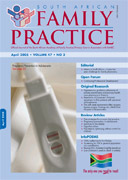CPD: Pregnancy Prevention in Adolescents.
Abstract
Although the pregnancy rate in adolescents has declined steadily in the past 10 years, it remains a major public health problem with lasting repercussions for the teenage mothers, their infants and families, and society as a whole. Successful strategies to prevent adolescent pregnancy include community programs to improve social development, responsible sexual behaviour education, and improved contraceptive counselling and delivery. Many of these strategies are implemented at the family and community level. The family physician plays a key role by engaging adolescent patients in confidential, open, and non-threatening discussions of reproductive health, responsible sexual behaviour (including condom use to prevent sexually transmitted diseases), and contraceptive use (including the use of emergency contraception). This dialogue should begin before initial sexual activity and continue throughout the adolescent years. (SA Fam Pract 2005;47(3): 24-28) (Reprinted from: Am Fam Physician 2004;70:1517-24. Copyright© 2004 American Academy of Family Physicians.) Permission from the AAFP was granted to publish this article in the hardcopy only. Kindly refer to www.aafp.org or subscribe to the hardcopy of South African Family Practice.
Published
2005-04-01
Section
Review Articles
By submitting manuscripts to SAFP, authors of original articles are assigning copyright to the South African Academy of Family Physicians. Copyright of review articles are assigned to the Publisher, Medpharm Publications (Pty) Ltd, unless otherwise specified. Authors may use their own work after publication without written permission, provided they acknowledge the original source. Individuals and academic institutions may freely copy and distribute articles published in SAFP for educational and research purposes without obtaining permission.

